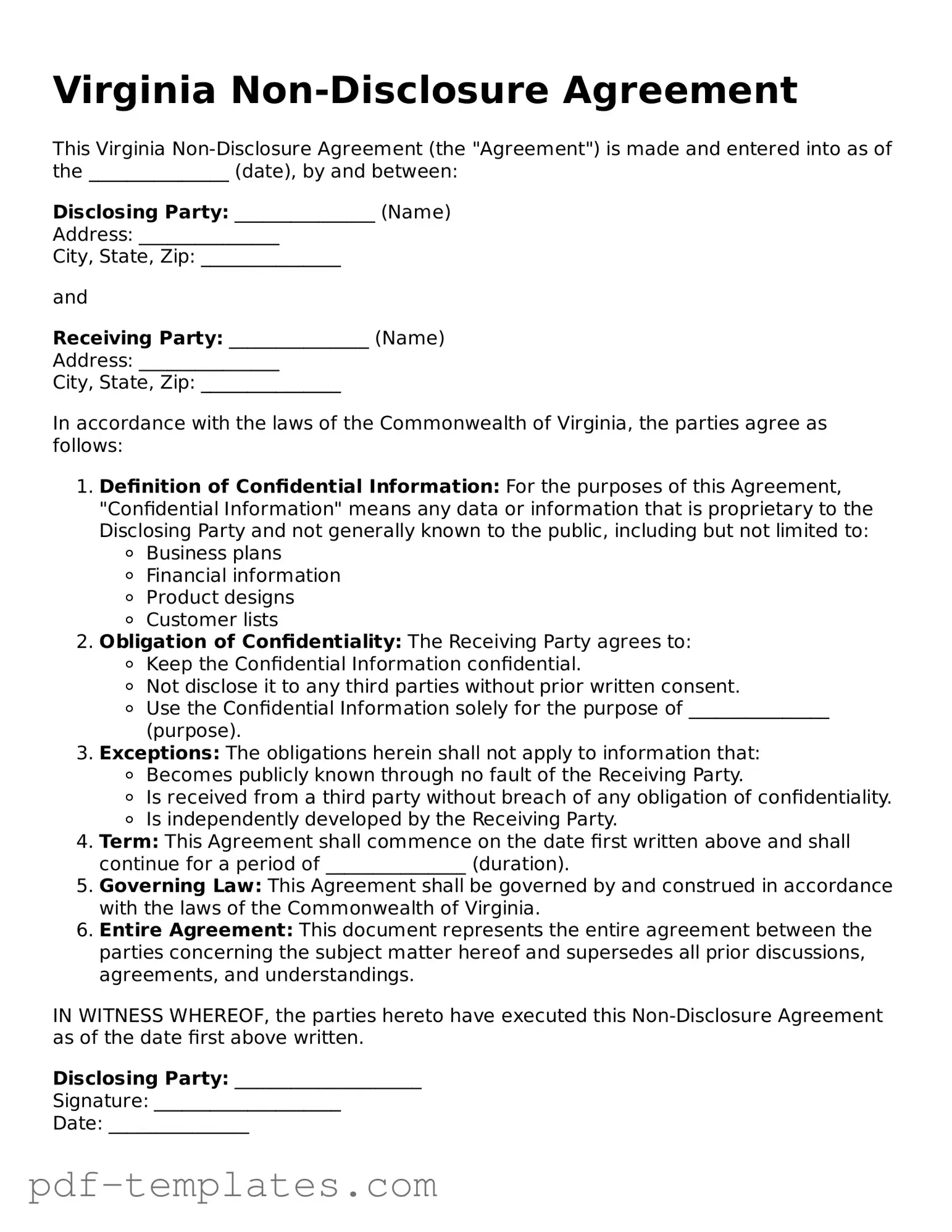The Virginia Non-disclosure Agreement (NDA) is similar to a Confidentiality Agreement, which serves a similar purpose of protecting sensitive information. Both documents aim to prevent the sharing of proprietary data between parties. Typically, a Confidentiality Agreement outlines the specific information that must be kept secret, the duration of the confidentiality obligation, and the consequences of breaching the agreement. This document is often used in various business settings, such as during negotiations or when sharing trade secrets, ensuring that both parties understand their responsibilities regarding confidential information.
Another document akin to the Virginia NDA is the Non-compete Agreement. While the NDA focuses on confidentiality, a Non-compete Agreement restricts an individual’s ability to work in a competing business for a specified period after leaving a company. The goal is to protect a business’s interests and prevent former employees from using insider knowledge to benefit competitors. Both agreements serve to safeguard a company’s intellectual property, but they do so through different mechanisms, with the Non-compete Agreement imposing limitations on employment opportunities.
A Mutual Non-disclosure Agreement is also similar to the Virginia NDA, but it involves two parties sharing confidential information with each other. This type of agreement is particularly useful in joint ventures or partnerships where both sides need to disclose sensitive information. The Mutual NDA outlines the obligations of both parties, ensuring that any information exchanged remains confidential. This document is crucial in fostering trust and collaboration, as both parties are equally bound to protect each other’s proprietary information.
The Proprietary Information Agreement shares similarities with the Virginia NDA by focusing on the protection of proprietary information. This document explicitly defines what constitutes proprietary information and sets forth the obligations of the receiving party. It serves to clarify the types of information that must be kept confidential, often including trade secrets, customer lists, and product designs. Like the NDA, this agreement is essential for businesses that need to share sensitive information with employees or partners while maintaining control over that information.
A Service Agreement may also bear resemblance to the Virginia NDA, particularly when it includes confidentiality clauses. This document outlines the terms and conditions under which services are provided, and it often contains provisions to protect confidential information shared during the course of the service relationship. By including confidentiality clauses, a Service Agreement ensures that sensitive information disclosed during the provision of services is not misused or disclosed to third parties, thus safeguarding the interests of both parties involved.
The Employment Agreement can be compared to the Virginia NDA, especially when it contains confidentiality provisions. This document outlines the terms of employment, including job responsibilities, compensation, and confidentiality obligations. By incorporating confidentiality clauses, the Employment Agreement helps protect a company’s sensitive information from being disclosed by employees during or after their employment. This dual focus on employment terms and confidentiality helps establish a clear understanding of the expectations surrounding the handling of proprietary information.
Finally, the Licensing Agreement is similar to the Virginia NDA in that it often includes confidentiality provisions when sharing proprietary information related to the licensed material. This document grants one party the right to use another party's intellectual property under specific conditions. By including confidentiality clauses, the Licensing Agreement ensures that the licensee does not disclose or misuse the proprietary information provided by the licensor. This protection is vital for maintaining the value of the intellectual property and fostering trust between the parties involved in the licensing arrangement.
